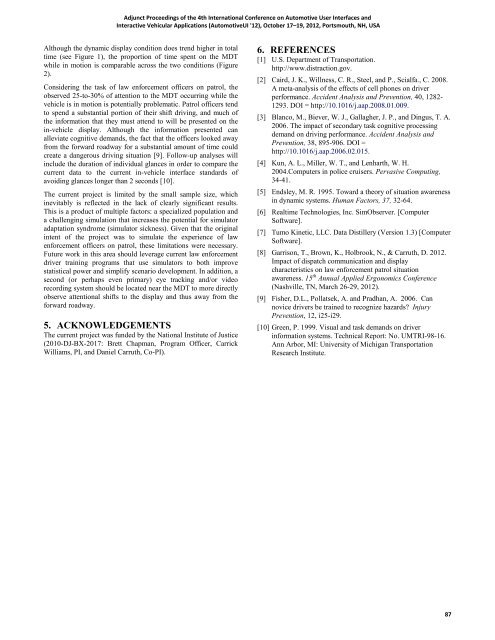12: Adjunct Proceedings - Automotive User Interfaces and ...
12: Adjunct Proceedings - Automotive User Interfaces and ...
12: Adjunct Proceedings - Automotive User Interfaces and ...
You also want an ePaper? Increase the reach of your titles
YUMPU automatically turns print PDFs into web optimized ePapers that Google loves.
<strong>Adjunct</strong> <strong>Proceedings</strong> of the 4th International Conference on <strong>Automotive</strong> <strong>User</strong> <strong>Interfaces</strong> <strong>and</strong><br />
Interactive Vehicular Applications (<strong>Automotive</strong>UI '<strong>12</strong>), October 17–19, 20<strong>12</strong>, Portsmouth, NH, USA<br />
Although the dynamic display condition does trend higher in total<br />
time (see Figure 1), the proportion of time spent on the MDT<br />
while in motion is comparable across the two conditions (Figure<br />
2).<br />
Considering the task of law enforcement officers on patrol, the<br />
observed 25-to-30% of attention to the MDT occurring while the<br />
vehicle is in motion is potentially problematic. Patrol officers tend<br />
to spend a substantial portion of their shift driving, <strong>and</strong> much of<br />
the information that they must attend to will be presented on the<br />
in-vehicle display. Although the information presented can<br />
alleviate cognitive dem<strong>and</strong>s, the fact that the officers looked away<br />
from the forward roadway for a substantial amount of time could<br />
create a dangerous driving situation [9]. Follow-up analyses will<br />
include the duration of individual glances in order to compare the<br />
current data to the current in-vehicle interface st<strong>and</strong>ards of<br />
avoiding glances longer than 2 seconds [10].<br />
The current project is limited by the small sample size, which<br />
inevitably is reflected in the lack of clearly significant results.<br />
This is a product of multiple factors: a specialized population <strong>and</strong><br />
a challenging simulation that increases the potential for simulator<br />
adaptation syndrome (simulator sickness). Given that the original<br />
intent of the project was to simulate the experience of law<br />
enforcement officers on patrol, these limitations were necessary.<br />
Future work in this area should leverage current law enforcement<br />
driver training programs that use simulators to both improve<br />
statistical power <strong>and</strong> simplify scenario development. In addition, a<br />
second (or perhaps even primary) eye tracking <strong>and</strong>/or video<br />
recording system should be located near the MDT to more directly<br />
observe attentional shifts to the display <strong>and</strong> thus away from the<br />
forward roadway.<br />
5. ACKNOWLEDGEMENTS<br />
The current project was funded by the National Institute of Justice<br />
(2010-DJ-BX-2017: Brett Chapman, Program Officer, Carrick<br />
Williams, PI, <strong>and</strong> Daniel Carruth, Co-PI).<br />
6. REFERENCES<br />
[1] U.S. Department of Transportation.<br />
http://www.distraction.gov.<br />
[2] Caird, J. K., Willness, C. R., Steel, <strong>and</strong> P., Scialfa., C. 2008.<br />
A meta-analysis of the effects of cell phones on driver<br />
performance. Accident Analysis <strong>and</strong> Prevention, 40, <strong>12</strong>82-<br />
<strong>12</strong>93. DOI = http://10.1016/j.aap.2008.01.009.<br />
[3] Blanco, M., Biever, W. J., Gallagher, J. P., <strong>and</strong> Dingus, T. A.<br />
2006. The impact of secondary task cognitive processing<br />
dem<strong>and</strong> on driving performance. Accident Analysis <strong>and</strong><br />
Prevention, 38, 895-906. DOI =<br />
http://10.1016/j.aap.2006.02.015.<br />
[4] Kun, A. L., Miller, W. T., <strong>and</strong> Lenharth, W. H.<br />
2004.Computers in police cruisers. Pervasive Computing,<br />
34-41.<br />
[5] Endsley, M. R. 1995. Toward a theory of situation awareness<br />
in dynamic systems. Human Factors, 37, 32-64.<br />
[6] Realtime Technologies, Inc. SimObserver. [Computer<br />
Software].<br />
[7] Tumo Kinetic, LLC. Data Distillery (Version 1.3) [Computer<br />
Software].<br />
[8] Garrison, T., Brown, K., Holbrook, N., & Carruth, D. 20<strong>12</strong>.<br />
Impact of dispatch communication <strong>and</strong> display<br />
characteristics on law enforcement patrol situation<br />
awareness. 15 th Annual Applied Ergonomics Conference<br />
(Nashville, TN, March 26-29, 20<strong>12</strong>).<br />
[9] Fisher, D.L., Pollatsek, A. <strong>and</strong> Pradhan, A. 2006. Can<br />
novice drivers be trained to recognize hazards? Injury<br />
Prevention, <strong>12</strong>, i25-i29.<br />
[10] Green, P. 1999. Visual <strong>and</strong> task dem<strong>and</strong>s on driver<br />
information systems. Technical Report: No. UMTRI-98-16.<br />
Ann Arbor, MI: University of Michigan Transportation<br />
Research Institute.<br />
87





